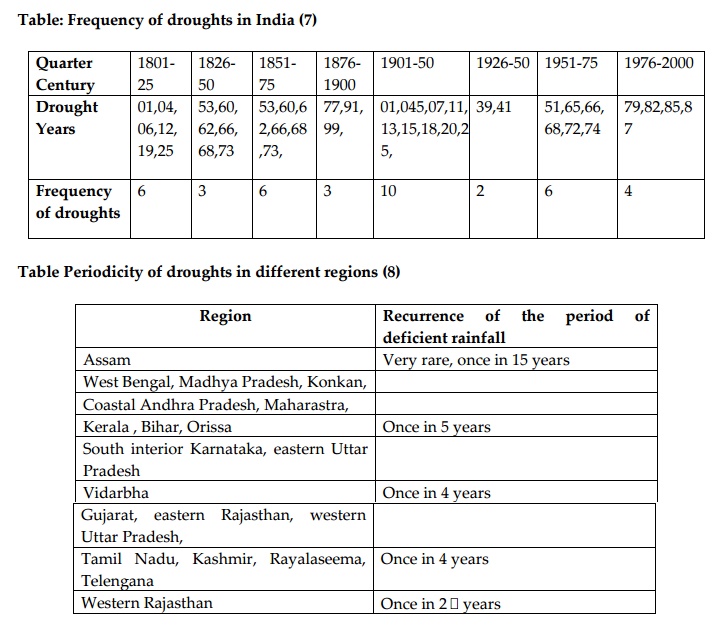Chapter: Civil : Water Resources and Irrigation Engineering : Irrigation Engineering
Need and Development of Irrigation in India
Need of Irrigation in India
The rainfall in India
is very erratic in its spatic as well as temporal variations. The average
annual rainfall for India has been estimated at 1,143 mm which varies from
11,489 mm around cherrapunji in Assam (with the maximum one-day rainfall equal
to 1040 mm) to 217 mm around Jaisalmer in Rajasthan. Besides, 75% to 90% of the
annual rainfall occurs during 25 to 60 rainy days of the four monsoon months
from June to September (2). In addition, there is also a large variation from
year to year, the coefficient of variation being more than 20% for most parts
of the 20% for most parts of the country (2).
Erratic behaviour of
the south-west monsoon is the maintdroughtscause (Table 1.0) and floods. The
recent proposal (Appendix-1) of the Government of India on interlinking of some
major rivers of the country is aimed at (i) increasing the utilizable component
of the country’s water
resources,problemsofshortages andexcesses(ii)ofwaterSol in some parts of the
country. Table shows the values of the approximate probability of deficient
rainfall (deficiency equal to or greater than 25 per cent of the normal) for
different regions (8) Dependability of rainfall is thus rather low from the
agriculture point of view and storage is essential to sustain crops during
non-monsoon periods and also to provide water for irrigation during years of
low rainfall. For a large part of any crop season, the evapotranspiration
(i.e., the water ned of a crop) exceeds the available precipitation and
irrigation is necessary to increase food
and fibre production.
About 45 per cent of agricultural production in India is still dependent on
natural precipitations. The need and important of irrigation in India can be
appreciated from the mere fact that the country would need to produce meet the
per capita requirement of 225 kg (i.e., about one-foruth of a tonne) per year
for an estimated population of 1,231 million in the year 2030.

Table: Frequency of droughts in India
(7)
Quarter Century 1801-25 1826-50 1851-75 1876-1900 1901-50 1926-50 1951-75 1976-2000
Drought Years 01,04,06,12,19,25 53,60,62,66,68,73 53,60,62,66,68,73, 77,91,99,
01,045,07,11,13,15,18,20,25, 39,41 51,65,66,68,72,74 79,82,85,87
Frequency of droughts 6 3 6 3 10 2 6 4
Table Periodicity of droughts in
different regions (8)
Region : Recurrence of the period of deficient
rainfall
Assam : Very rare, once in 15 years
West Bengal, Madhya Pradesh, Konkan, Coastal Andhra
Pradesh, Maharastra, Kerala , Bihar, Orissa :
Once in 5 years
South interior Karnataka, eastern Uttar Pradesh
Vidarbha, Gujarat, eastern Rajasthan,
western Uttar Pradesh, : Once in 4 years
Tamil
Nadu, Kashmir, Rayalaseema, Telengana : Once in 4 years
Western Rajasthan : Once in 2 years
In addition, the export
of agricultural products earns a major part of foreign exchange. Because of
vastly different climate in different parts of the country, a variety of crops
are produced in India. The country exports basmati rice, cotton, fruits (mango,
apple, grapes, banana etc), vegetables (potato, tomato etc). Flowers (rose
etc.) and processed food products in order to earn
precious foreign
exchange. Still further, about seventy percent of the country’s on i facilities
in the country.
Development of Irrigation in India
Among
Asian countries, India has the largest arable land which is close to 40 per
cent of
Asia’s arable land (6).
Only USA hasbeenmorepractised ara throughout the world since the early days of
civilization. In India too, water conservation for
Augmentation of crop
yields. New high yielding varieties of crops have higher water requirement for
giving higher yields. Sugarcane and rice have higher requirements of water.
Exacting water
requirement. The high yielding varieties of crops have more exacting
requirement of water.
Cash crops cultivation.
Cash crops require higher and assured supply of water with frequent watering
for maturity.
Assured water supply.
For successful arming, availability of water in needed quantum and at right times
is very essential.
Orchards and gardens.
Fruit trees grown in orchards and garden high higher requirement of water.
Related Topics